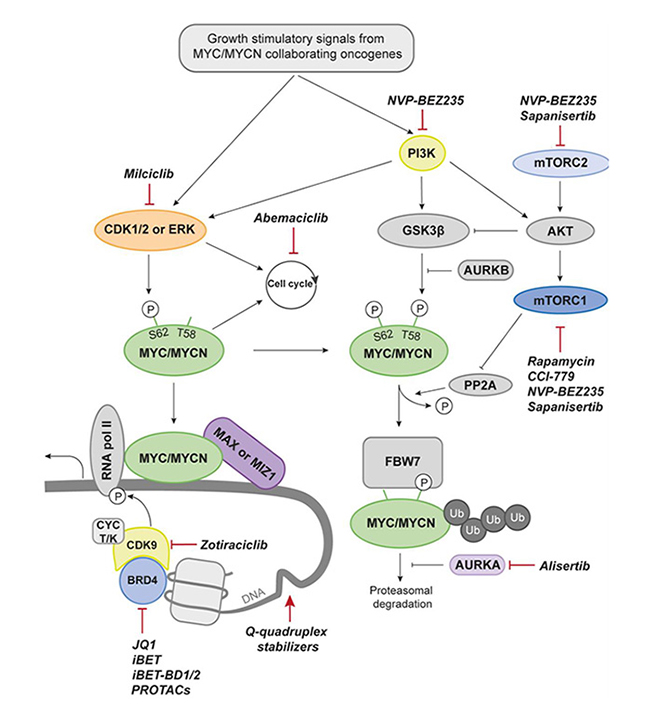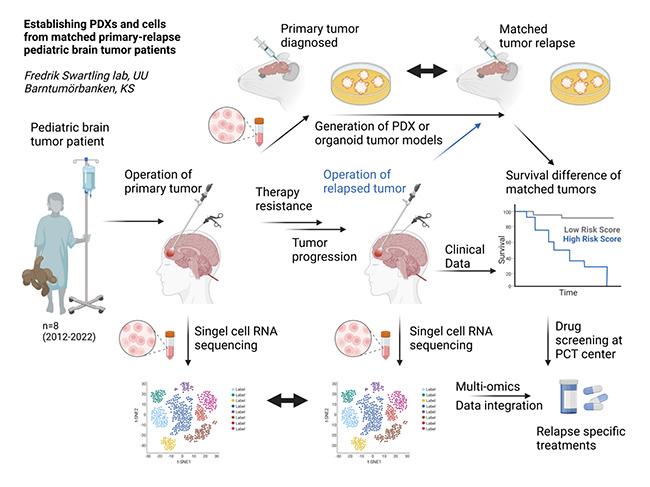Research
Overview
Mechanisms behind childhood brain tumors
MYC proteins (like MYC or MYCN) are transcription factors and PDGF proteins and their receptors are growth factors which all have essential roles in normal brain development. Misexpression of MYC proteins occurs frequently in medulloblastoma, the most common malignant childhood brain tumor of the hindbrain and PDGF and its receptors when mutated or amplified, promote the growth of malignant gliomas.
MYC or MYCN amplifications in medulloblastoma are strongly correlated with poor prognosis, suggesting that MYC proteins are clinically relevant targets for brain tumor therapy. MYC and PDGF proteins are also amplified or overexpressed in diffuse midline gliomas of in the childhood brain stem and in certain subtypes of glioblastoma, high grade malignant brain tumors typically occurring in the forebrain of adults.
Tumor origin and therapy resistance
Our research group explores how MYC proteins generate malignant brain tumors with a focus on identifying cells of tumor origin. We study critical pathways involved in relapse driven by another protein SOX9 that is important for stem cell features but also in promoting therapy resistance.
We have generated clinically relevant molecularly defined models for MYC/MYCN-driven brain tumors and we also study a large number of primary cell lines obtained from childhood brain tumor patients. Finally, we are developing forward genetic screens, clonal cell analysis, drug screening and novel computational models to understand the genomics, transcriptomics and epigenetics of these tumors at the single cell level.
List of projects
-
In search for the cellular origin of childhood brain tumors
-
Miao Zhao, Oliver Mainwaring, Gabriela Rosén, Fredrik Swartling
Medulloblastoma is divided into four distinct molecular subtypes (WNT, SHH, Group 3 and Group 4). Group 3 medulloblastoma presents with a large proportion (15-20%) of MYC amplifications (Hovestadt et al. Nat Rev Cancer, 2020) and correlate with poor prognosis. MYC proteins are unstable oncoproteins with short half-lives.
We have shown that MYCN generates Group 3 tumors from a glutamate transporter (GLT1) promoter in a transgenic inducible model (GTML) of medulloblastoma (Swartling et al. Genes & Dev., 2010) and found that tumors originate from a GLT1-positive photoreceptor-positive progenitor cell.
Transgenic mouse model
There are currently no transgenic mouse models for MYC-driven pediatric brain tumors, so we developed an inducible transgenic model (called GMYC), which is driving MYC from the Glt1 promoter (Mainwaring et al. accepted in Nat. Comms., 2023). Aggressive Group 3 tumors are generated with good penetrance in the GMYC model. tumors histologically and molecularly resemble human Group 3 medulloblastoma.
We also found that the CDKN2A tumor suppressor gene upstream of the p53 pathway is silenced in the MYC-driven model, as compared to our older MYCN-driven model. When CDKN2A was knocked out early, the model induced pediatric high grade gliomas (pHGGs) which resemble RTK-driven or G34 mutant pHGG subtypes.
In the search for the true cell of origin of this brain tumor, we perform analysis using cell fate tracking (using Confetti models) and single-cell RNA sequencing (scRNA-Seq) analysis of hindbrain regions at different developmental time point before and after tumor formation.
-
Novel models of medulloblastoma and high-grade glioma for use in targeted treatment studies
-
Karl Holmberg Olausson, Géraldine Giraud, Gabriela Rosén, Tobias Bergström, Fredrik Swartling
In this project we are transforming human iPS-derived cells and embryonic hindbrain neural stem cells in order to model the different subgroups of medulloblastoma using lentiviruses carrying clinically relevant cancer driver genes for the distinct tumor subgroups. We have recently shown that MYCN overexpression can induce infant SHH-driven tumors from these types of human stem cells in vivo (Čančer et al. Cell Stem Cell, 2019).
Depending on cellular origin and OCT4-reprogramming status, tumors of varying prognosis developed. When OCT4 was induced it promoted mTOR pathway signalling in tumor models and human PDXs. We therefore showed that tumors were dependent on this pathway (see Figure 1) and that mTORC inhibitors could be used to effectively treat these MYCN-driven infant brain tumors.

Modelling tumor development
We are also transforming brain stem-specific cells from humans and mice with MYC in order to model medulloblastoma or diffuse-intrinsic pontine glioma (DIPG) development. We will evaluate the relevance of using well-defined human hindbrain stem cells to generate these childhood brain tumors and we will compare them to subtype-specific cells similarly cultured from medulloblastoma or DIPG patients. We further develop and study patient-derived xenografts and evaluate their use in drug screens in combination with radiation therapies in co-culture systems with organoid (3D) cultures.
We hope we will understand what actually drives the initiation of medulloblastoma and DIPGs and if various subgroups match certain hindbrain cell types. We currently use genetic and epigenetic analyses to find prognosis markers. We hope to predict how some of these tumors could be treated or if they would be resistant to certain targeted therapies.
-
Targeting MYC in childhood brain tumors by using CDK2 suppression
-
Tina Lin, Anna Borgenvik, Fredrik Swartling
We have shown that MYCN levels and early proliferation of brain tumors could be reduced by specific inhibition of the bromodomain inhibitor JQ1, which targets MYC proteins epigenetically (Bandopadhayay et al. Clin Can Res., 2014). We also found good efficacy controlling MYCN stabilization by using a CDK2 inhibitor called Milciclib (Bolin et al. Oncogene, 2018) or by using Aurora Kinase inhibition in glioblastoma cell lines (Čančer et al. Cell Death & Disease, 2019) in combination with JQ1 (Figure 1).
We are currently evaluating the role of complete CDK2 inhibition during tumor initiation and downstream CDK treatment effects in our models, especially the GMYC model in vivo. Our goal is to understand the efficacy and underlying mechanisms of MYC inhibition in cells and further evaluate the potential of using combinations of promising MYC-targeting drugs in the clinic.
-
A new model for childhood brain tumor recurrence
-
Tina Lin, Karl Holmberg Olausson, Thale Kristin Olsen, Anders Sundström, Géraldine Giraud, Fredrik Swartling
Despite precise surgery, intensive irradiation treatment and various combinations of chemotherapy, medulloblastoma can relapse which is associated with very poor prognosis in children. In this project we are studying how MYCN interacts with SOX9, a transcription factor involved in glial fate determination in the brain. Few scattered SOX9-positive cells are found in GTML tumors that are similar to Group 3 human MB.
By using a combination of Tet-ON and Tet-OFF inducible systems we managed to target this rare population of SOX9-positive GTML tumor cells in vivo to show how they were capable of initiating tumor recurrence (Borgenvik et al. Cancer Res. 2022).
We also showed how FBW7 is regulating SOX9 stability and increases tumor cell migration and metastasis (Suryo Rahmanto et al. EMBOJ, 2016). By suppressing the mTOR/PI3K/AKT pathway we can obstruct this stabilisation (see Figure 2). Further characterisation of SOX9-positive tumor cells using expression profiling (including scRNA-Seq) and ATAC-Seq will help us understand the mechanisms behind metastatic medulloblastoma recurrence.

-
Mechanisms of pediatric brain tumor relapse using standard radiation therapy in vivo
-
Miao Zhao, Tobias Bergström, Erika Dalmo, Gabriela Rosén, Holger Weishaupt, Géraldine Giraud, Fredrik Swartling
It is not known which types of tumor clones are surviving standard treatment and give rise to tumor relapse. In order to study the recurrence mechanism of medulloblastoma and high-grade glioma, we will use a barcoding technique using lentiviral vectors to study the clonal evolution of cells that survive radiation. Barcode labelling will be performed on transplanted cells/PDXs in animals that are undergoing standard radiation treatments.
In this project, we will compare primary tumors with recurring tumors that escape radiation therapies using scRNA-Seq to detect the specific barcodes. We will also collect fresh biopsies from matched pairs of primary-recurrent samples (focusing on high-grade glioma, medulloblastoma but also ependymoma) in collaboration with Barntumörbanken, Karolinska Institutet (Figure 2).
We aim to see if cells with particular expression of genes and distinct signalling pathways are enriched in recurrent tumor cells as compared to matched primary tumor cells. It would be important to see if minor or major clones from the primary tumor are driving relapse and we finally hope to identify distinct molecular therapies that can specifically target relapsing cells.
-
Using forward genetic tools to identify candidate cancer genes of virally-induced glioma and neural network analysis to predict brain tumor progression
-
Holger Weishaupt, Oliver Mainwaring, Anders Sundström, Fredrik Swartling
To study pathways involved in glioma development, we have used a retrovirus-driven PDGFB-induced murine glioma model that causes tumors that closely resemble human gliomas (Weishaupt et al. Neuro-Oncol., 2022). Retroviruses have a capacity to induce so called insertional mutagenesis and thereby promote brain tumor formation.
We have used whole genome sequencing methods and developed computational algorithms to identify several potential genes that, together with PDGFB, induce brain tumor development. We are currently functionally evaluating some of our top candidates and investigating their distinct roles in brain tumor biology.
Genetic defect involved in tumor development
Amplification of Chr. 17q or isochromosome 17q is the most common chromosomal defect in tumors that depend on MYC or MYCN, including neuroblastoma, certain leukaemia (e.g. CML) and medulloblastoma, to mention a few tumor types. Despite this region being so frequently (70 %) amplified with MYC genes, it has been impossible to identify the gene or those genes responsible for helping MYC in driving tumor development.
We have developed batch-normalization tools (Weishaupt et al. Bioinformatics, 2019) to combine larger cohorts of molecularly analysed brain tumors in order to perform a more statistically relevant analysis of Chr 17q genes. We have then employed advanced neural network analysis from multi-omics data from these larger patient cohorts and used computational models and machine learning